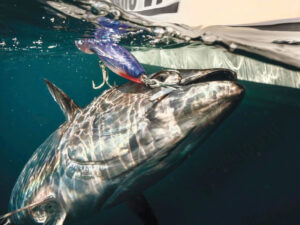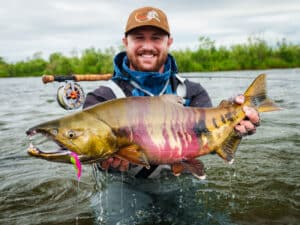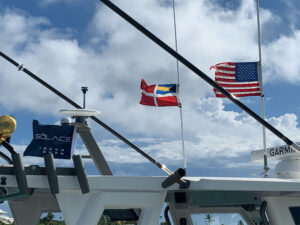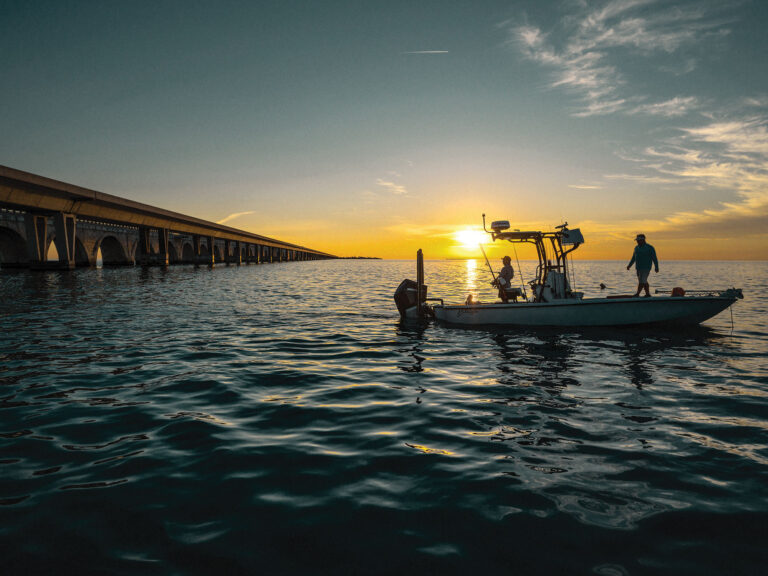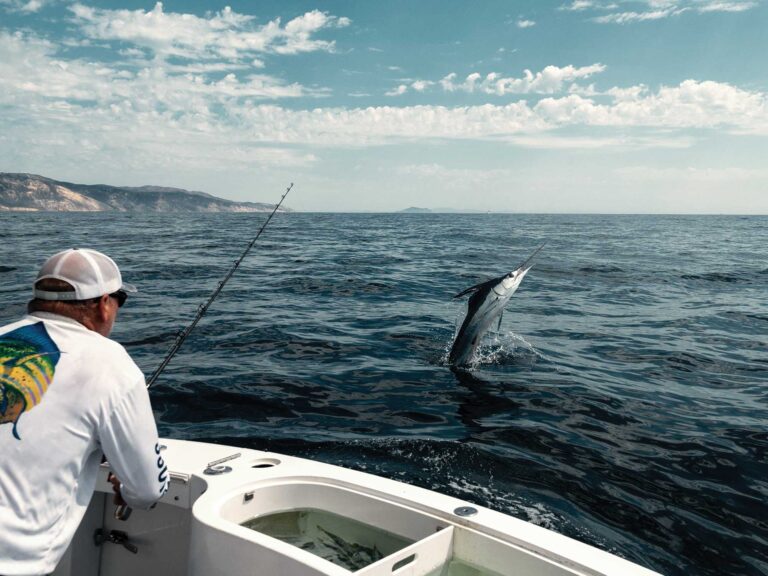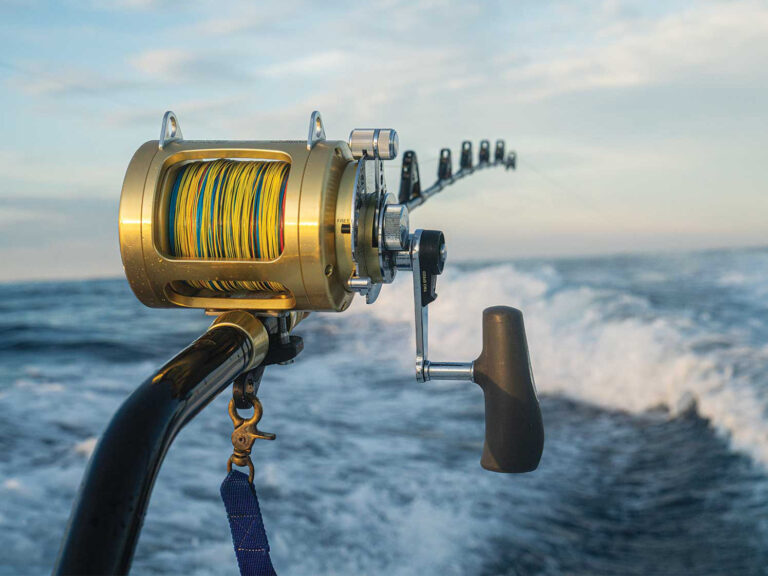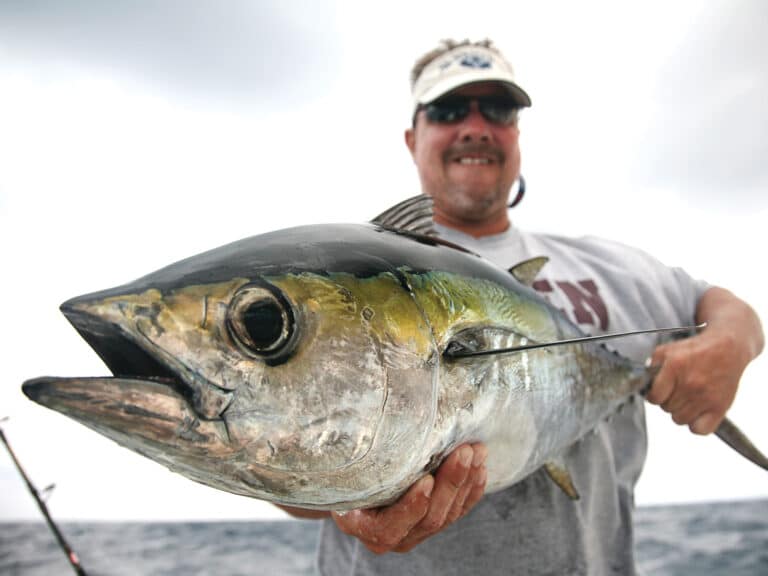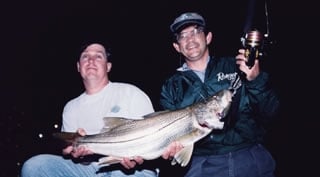
| Nocturnal mission: Anglers have discovered that South Florida’s normally cautious snook feed with abandon at night around illuminated docks, bridges and breakwalls that draw in baitfish. |
I heard the distinctive pop of feeding snook long before I saw the surface swirls and boils. It’s a sound that never fails to make my hands tremble and my blood percolate. hands tremble and my blood percolate. Several large docks loomed ahead in the dark. At the end of each was a light that clearly revealed the pilings, cross supports, and dock lines in the clear tidal flow.
Phil O’Bannon guided his flats skiff forward with an electric motor, keeping low and speaking softly. As we closed the distance, the popping became louder and more frequent. Then I saw the splashes and the dark shapes of fish cruising in and out of the shadows. Most were small snook that were circling slowly, but occasionally an oversize shape would materialize from the depths or dark edges of the light.
“Plenty of fish around the right dock, far right piling,” Phil said. “See ’em? Oh, there’s some good fish, too. Just cast upcurrent, let the fly swing with the tide and make slow, deliberate strips.”
I flipped out a 40-foot cast and dropped my fly just uptide and beyond the ring of light where the snook buffet party was taking place. I allowed the sparsely tied streamer to settle deep and drift into the light, then started a slow retrieve.

Small, maneuverable skiffs equipped with electric trolling motors are ideal for working the confines of a canal.|
Even though I was expecting a strike, the take was so fast and violent that it came as a shock. Instinctively, I hauled back on the rod in a vain attempt to thwart the fish’s run, which took the line through the ragged dock pilings. In an instant it was gone. Slack line, broken leader, tension severed, dreams of snook glory exploded.
“That was a helluva snook,” Phil said quietly.
“I know,” was all I could say.
Snook in the Dark
For a dedicated cadre of South Florida snook fanatics, it’s no secret that nighttime is the right time for huge linesiders. Most of these fishermen are jetty, pier and bridge jockeys or a specialized crew of pass anglers who fish deep lures and baits primarily in spring and summer. But over the years, anglers have learned that great fishing can also be found around lighted docks, bulkheads and bridges on both coasts of Florida through most of the year.
Over the last ten or 15 years, waterfront homes in the Sunshine State have increased by the thousands, and many feature well-illuminated docks. Those dock lights attract lots of baitfish, as well as the snook that feed on them, and the result has been a boon to anglers.
Anyone who fishes for snook knows that catching them can be hit-or-miss, at least during the day. But at night the situation swings in favor of the fisherman. The waterways are quieter and the snook let their guard down as they go on the hunt. This is true on both coasts of South Florida, from Cape Canaveral south on the east coast and from Port Richey south on the west coast.
While night fishing around lighted docks, bridges and bulkheads can be outstanding almost anywhere in snook country, some of the very best action takes place in the most heavily boated parts of the state. During the day, such places may teem with boats, personal watercraft and the general hustle and bustle of waterfront life. But when the sun sets – especially during mid-week – things change dramatically.

While light tackle works fine on small snook, it won’t do much to prevent larger fish from parting the line on a piling. Best bet is to beef it up.|
Joel Brandenburg is a dedicated snook fisherman who lives near Tampa Bay. Each month, he and a friend fish the pilings of the marina where the latter keeps his 40-foot boat.
“We meet for dinner and take our time getting down to his boat,” says Brandenburg. “Then we sit on the stern and simply cast soft-plastic jerkbaits and shrimp-like lures around the dock pilings. The fish show up when all the boat traffic and marina activity shuts down for the night. We always catch a dozen or so snook, and we’ve had nights when we caught 40 fish, including some to 20 pounds. I’ve hooked bigger ones, but you just can’t land them around the pilings on light tackle.”
Snook Show Nightly
This kind of action is about as predictably good as any inshore fishing in the state. For years I believed that night snook fishing was best during the hottest months of the year, especially near the passes and inlets during the snook spawn. However, as I learned last winter from Stuart guide Ed Zyak, the lighted docks produce plenty of cold-season snook, too.
“I think that the snook and bait are drawn to dock lights in winter because the lights give off warmth, and that turns the fish on,” says Zyak. “The fish aren’t as big as in the spring and summer, but we catch lots of three- to eight-pounders, and they’re setups on light tackle and streamer flies.”
One night, Zyak took me, my son Eric and friend Sam Heaton on a night snook trip in mid-January. Virtually every dock we fished held good numbers of snook. We caught eight and lost at least as many others in just an hour of fishing using one-inch, sparsely tied streamers. Our best fish was five pounds, but we saw larger ones. In addition, we caught some bonus seatrout and jack crevalle, plus a large number of oversize lookdowns. Remarkably, we saw only two other anglers the whole night. Of course, this might be expected in mid-week, but Zyak says that almost no one fishes the docks for snook in winter, which likely is one reason fishing for them is so out-standing.
| ### Night Lights |

SureFire G2 Nitrolon|
One drawback to night snook fishing is that anglers often can’t see what they’re doing, which leads to tangled lines, leaders, hooks and a sense of frustration that often sends the novice heading for the dock after an hour or two.
The way to combat such nighttime problems, of course, is with a flashlight. One option is a battery-operated headlamp, which keeps both hands free for tying knots, unhooking fish, and so forth. Another is a small, powerful flashlight that fits in your pants or shirt pocket and can be held between your teeth or clipped to a hat brim when two hands are needed. By far the best flashlights I’ve used are made by SureFire (800/828-8809; www.surefire.com), whose lights are favored by police and the military. The company makes a wide variety of small, powerful, rugged and waterproof flashlights, some of which come with small clips for attatching them to clothing or hats.
My favorite SureFire is the best-selling G2 Nitrolon. It measures only six inches long and is powered by two small lithium batteries, but is so bright that I have used it to steer my way through a channel at full plane. SureFire also makes interchangeable lenses in red or blue, which produce a light that does not seem to alarm snook as much as a bright white light, yet still offers plenty of illumination.
There is a tendency for some anglers to carry big, bright lights for night fishing. But for accurate casting to docks, piers and bulkheads, too much light can be a detriment. Bright lights overhead can blind anglers and make it difficult to see fishing targets when casting. Therefore, it’s best to have some type of subtle light low to the deck.
A small, battery-operated lantern that uses two small, fluorescent bulbs is just the ticket. I like to station the lantern on the deck near the console, where it produces a low light that allows for safety while fishing, yet doesn’t blind the anglers. Plus, when I need a strong light to help me tie on a new lure or hook, the lantern is just a couple steps from the bow or stern. – Bob McNally
This seems to hold true in other parts of the state. Joel Brandenburg and his friend Billy Noble report that few fishermen tap into cold-season night snook fishing in the Tampa Bay area, even though the fishing can be excellent.
Although excellent night fishing can be enjoyed on both sides of Florida, you’ve got to do some homework to achieve consistent success. For example, a little trial-and-error searching will reveal which docks and bridges produce best. Here are some other guidelines for improving your linesider results.
The Right Lights
Lighted residential docks are among the most popular and productive snook hangouts. Dock lights that are positioned low to the water and have an intense white beam were obviously put there by the homeowner to attract fish, but almost any light, of any intensity, produce good fishing. Don’t overlook even the faintest or smallest dock or bulkhead light. In fact, some of the very best action for the biggest snook is found beneath towering bridges with only a glimmer of light shining down.
“Snook like to hold along faint shadow lines under bridges, usually close to the big bridge pilings,” explains Stuart guide John Meskauskau. “Moving water is important for night bridge fishing, and you’ve got to be patient. Snook can be finicky, even at night, especially bigger fish in deep water.”
It often takes a few minutes to recognize a shadow line in the inky darkness of a moonless night. It occurs where the shadow of the bridge meets the reflected light shining down from above. It’s not easy to see, but you can bet that snook will line up along that edge.
Similarly, much of the best fishing occurs around the edges of dock and bulkhead lights. Many veteran snook anglers favor making initial casts to the upcurrent side of the light edges and fishing the area thoroughly before casting to other places. Often the biggest snook will hold in the shadows around the light.
Keep It Slow
While a snappy, whippy retrieve that stirs up lots of commotion often works on snook during the day, night fishing demands a slow, steady approach. In fact, it’s often best to let the fly or lure simply drift with the current or even tumble along the bottom. Keep a tight line and watch and feel for a strike, but a dead drift is often most effective.
In winter, deep, secluded residential canals may produce some of the best night fishing because the water in them is of a more moderate temperature than open-water areas. During the warm months, however, docks that experience good tidal flow, as well as areas near passes and inlets, shine because they hold more bait. For this reason, many night anglers favor strong-running tides during the new and full moon.
|||| |—|—|—| |### Night Snook Guides| Many guides specialize in after-hours snook fishing in South Florida. Below are some of the guides who provided input for this article. For the names and numbers of additional guides, see “The Traveling Fisherman” section in the back of this magazine. Paul Hobby, Ft. Myers, (239) 433-1007Dave Markett, Tampa, (813) 962-1435John Meskauskau, Stuart, (772) 463-7511or 529-4484Billy Nobles, Apollo Beach,(877) FLA-FISHPhil O’Bannon, Boca Grande, (941) 964-0359Geoffrey Page, Venice, (941) 408-9712Ed Zyak, Jensen Beach,(772) 485-FISH
Naturally, night snooking is a stealth game. A good electric trolling motor is almost mandatory, and boat noise should be kept to a minimum if you want to get close to big fish. Be courteous, too, since docks are private property and boat owners have a bundle wrapped up in their waterfront homes. Most people don’t mind courteous anglers fishing around their docks, but if you foul a lure, cut the line and leave it. Never trespass on private property; not only is it illegal, it’s sure to screw up the fishing.
Stealth has other advantages. You’ll often hear snook feeding on the surface, sometimes far from the dock lights. I always cast to such “pops,” and every once in a while I am rewarded with a good fish.
Weedless, unweighted, soft-plastic jerkbaits are hard to beat for this kind of fishing, since they seldom foul and do a good job of imitating the small glass minnows on which the snook so often feed. As mentioned, fly fishermen will do well with small, sparsely tied streamers.
Perhaps the best part of night snook fishing is that it’s close by and easy to access in a small boat. In many parts of the state, especially around large metropolitan areas, there’s no need for long boat runs or extensive preparation. In fact, if you’re new to the night game, keep your trips short and simple until you learn the ropes. Often you’ll only need to work a few lighted docks to get into fish, and it’ll only take one good snook to get you hooked on some of the best light-tackle action the Sunshine State has to offer.
| ### Snook Tackle |



(top) Weedless, soft-plastic lures are just the ticket for nighttime snooking. (middle) A variety of jerkbaits, rigged to prevent snags, will take snook around the lights. (bottom) Surface plugs can draw hits from night-feeding snook by raising a ruckus.|
Simplicity is the order of the night, at least when it comes to dockside snooking. Use gear you’re most familiar with, because you don’t need tackle problems at night, especially with hard-fighting snook.
Most Floridians use medium-action spinning tackle or fly gear. A 6 1/2- to 7 1/2-foot spinning outft spooled with ten- to 20-pound line is good (braided line is preferred by many anglers for its abrasion resistance and low stretch). Tie a Bimini twist or Spider hitch in the line to form a two-foot loop, then tie on a four-foot shock leader of 30- to 50-pound fluorocarbon. Tie all lures and hooks directly to the leader; loop knots are preferred.
Many different artificial lures will take nighttime snook. Two of my favorites are the D.O.A. Glow Shrimp and D.O.A. TerrorEyz jig. Other snook standards include the Bomber Long A; MirrOlure 52M series; soft-plastic jerkbaits such as the Shad Assassin; small surface plugs like the Excalibur Super Spook Jr., Spin’n Image, and Swim’n Image. Many different jigs in the 1/4- to 3/8-ounce sizes also are effective. In the fly department, small, sparse bucktail and FisHair streamers, little epoxy flies and shrimp imitations work well. – Bob McNally

